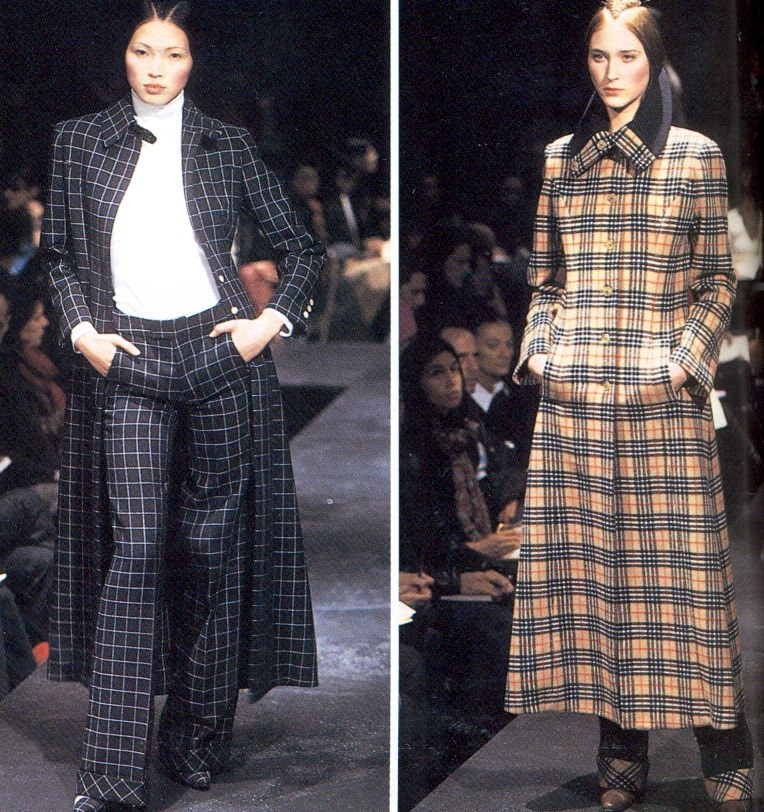Laura Hawkins speaks to the lauded designer about his revolutionary collection, which repurposed Burberry plaids, Hermès belts and Yankees baseball caps as a critique of capitalist consumerism
A stamped dollar bill was the coveted invite to the second A/W00 runway show of Miguel Adrover, the Mallorca-born designer whose lauded debut S/S00 collection featured a Louis Vuitton bag repurposed as a mini-skirt, an American flag reimagined as a tailored jacket and shorts, and an 'I love New York' T-shirt customised with ruffled tulle. With design narratives which considered the possibilities of repurposed garments, Adrover’s A/W12 collection (presented after an eight-year hiatus operating as an eponymous label, and his last collection to date) imagined Amazonian inhabitants dressed in garments ejected from a plane, and his recycled aesthetic has included pieces created from the clothes of his grandparents, the contents of downtown dumpsters, and even a leather skirt made using a jacket that was a birthday gift from Alexander McQueen.
A designer preoccupied with the creative restrictions of commercialism (Adrover wore a T-shirt printed with 'Anyone see a backer?' at the close of his S/S05 show, a response to his loss of financial support from Pegasus Apparel Group in 2001), his A/W00 Meettown show was a sublime subversion of capitalist symbols, elegant tailoring and deconstruction. Extolled by Marion Hume in the May 2000 issue of Harper’s Bazaar US as 'New York’s latest style supernova', here we examine the components of Adrover’s radical collection.
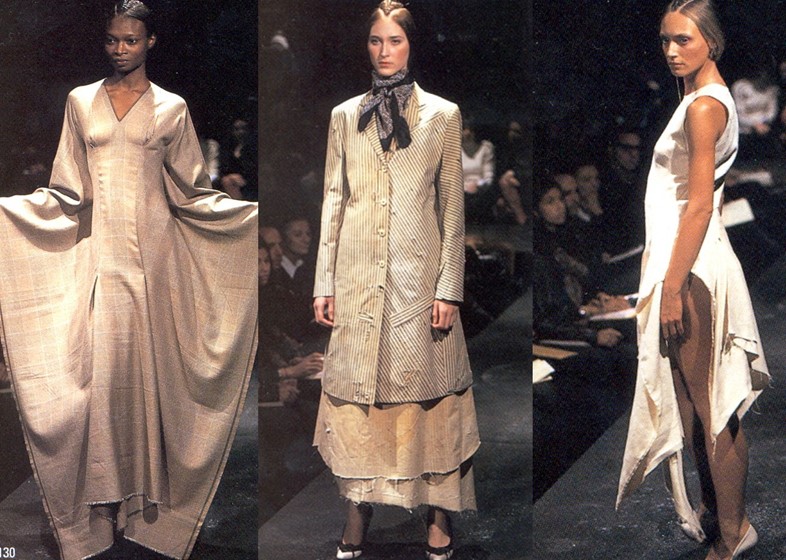
The Show
Presented at 9pm on February 6 at the Clemente Soto Vélez Cultural Centre on Suffolk Street (the same location as Adrover’s debut and A/W12 shows), models navigated a T-shaped catwalk imagined as a city crossing. The set included steaming manhole covers, and models walked to the chaotic sounds of screeching cars and pouring rain, recorded on Williamsburg Bridge. "It was really about uptown and downtown and this place where people meet," Adrover explains over Skype from his rural home in Mallorca (he left New York City in 2004). "The streets of New York were a big inspiration; you could be an upper-class lady from Park Avenue or homeless person from Chinatown."
A nod to the Louis Vuitton mini-skirt in Adrover’s debut line, models wore logo-stamped symbols of luxury, reimagined and distorted. A Burberry mac was turned inside out and reconstructed as a plaid dress; two pairs of trousers, one pair resewn into a cropped jacket, were paired with Hermès belts, and a navy sweater with shoulder pads created using New York Yankees baseball caps. Elegant cowl neck sweaters and trouser suits were imbued with a dash of downtown, created with recycled upholstery fabrics and finished with raw edges. A striped overcoat, distressed and burnt on a stove in Adrover’s basement on East 3rd St was made using the mattress of the recently deceased writer Quentin Crisp. "We were neighbours," Adrover explains. "He died in the wintertime and his belongings were thrown away. He told me he never cleaned his apartment, because dust was the part of life."
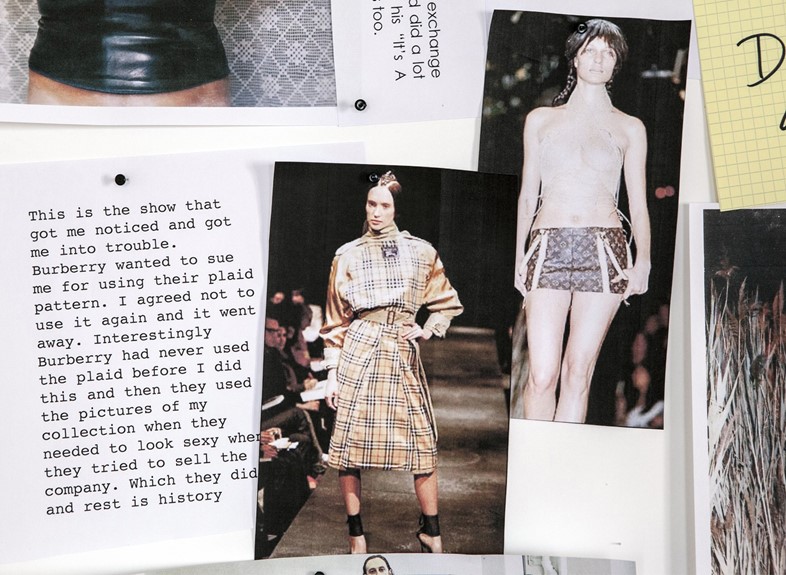
The People
"There was this moment of underground excitement that Miguel had that I don’t think existed before him in New York," explains Jenn Rossi, who after working in Horn, the boutique Adrover opened in 2005 before launching his own label, has worked with him since his debut collection. Marion Greenberg, who represented Givenchy and Jil Sander, and had been introduced to Adrover through his friend Alexander McQueen (then the creative director of Givenchy), handled the front of house PR. American Vogue’s Anna Wintour and Grace Coddington, Amy Spindler of the New York Times, and Brana Wolf, editor-at-large of Harper’s Bazaar US, all attended the show. "We were doing this simple staging but our set guy just wasn’t getting our idea," Rossi says. "I was almost crying and saying, 'Anna Wintour is going to be here!' and he was like 'She’s not actually coming.' I remember sleeping overnight at the venue because we were worried people might not be able to come out or get in."
In the run-up to the show, Adrover’s only seamstress, Mei Zou, machine-stitched pieces from Adrover’s windowless basement, where Adrover also cast his models and muses, including Gloria and Pila Sanchez and Macarena Nuñez, with the stylist Eric Daman. In 2001, Daman was hired by Patricia Field as assistant costume designer on Sex and the City, and later designed for the series Gossip Girl. "We could never pay anyone," Adrover tells me. "The only reason the show even happened is because of American Vogue. The Louis Vuitton mini-skirt and an anaconda skin coat from my first collection got stolen when they were being shot for the magazine. A messenger stole the pieces, and gave them to his girlfriend who was a stripper. Vogue gave me $2000 for them."
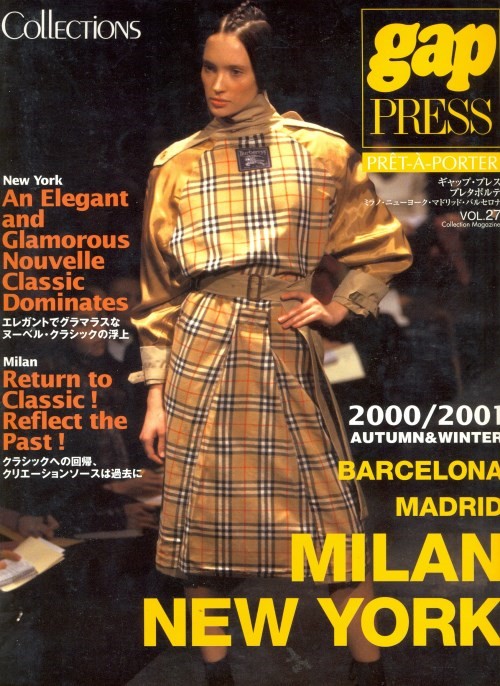
The Impact
Adrover’s show was held an hour after that of Diane Von Furstenberg, a designer who achieved stratospheric commercial acclaim after inventing the jersey wrap dress. Adrover was praised for his deconstruction, intellectualism and romance, aesthetic codes rarely seen during the sales-driven shows at New York Fashion Week, and his underground aesthetic echoes the recent rise in subversive New York designers, from Hood by Air to Eckhaus Latta, Vejas to Gypsy Sport.
On Febuary 7 a long Burberry coat from Adrover’s collection made the cover of Women’s Wear Daily, with Adrover labelled as 'New York’s New Star.' Burberry threatened a lawsuit, asking that Adrover never use their plaid patterning again. In 2001 they announced their plans for an IPO. Commenting on the repurposing of Quentin Crisp’s mattress, Cathy Horyn of the New York Times remarked, "The designer’s salvaging of this piece of urban detritus, with its forlorn history and stains, and transforming into a tailored coat was less recycling than poetic invention." Both pieces are now part of the Costume Institute archive at The Metropolitan Museum of Art. "The Burberry and Quentin Crisp pieces are examples of how everything Miguel did had a point of view beyond the clothes themselves… The fact he has many pieces in museums is testament to his influence on contemporary fashion," explains Gill Linton, the founder of avant-garde vintage shopping app, Byronesque.
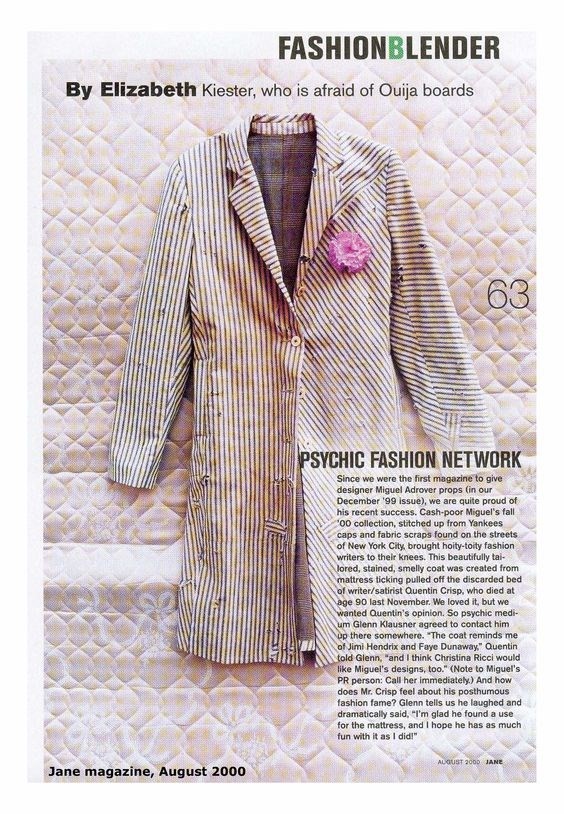
Linda Dresner, who owned an eponymous Park Avenue boutique at the time, and bought pieces from Adrover’s early collections, tells me, "Miguel was the innovator of originality. With him, old became new again." From blown up Ralph Lauren emblems on T-shirts, to Marlboro logo faded shirts and Coca-Cola print baseball vests, Adrover consistently used logos in his collections as symbols of capitalist culture, and to highlight the over-reliance of the consumer on recognisable visuals. "I used logos my entire career, but in my moment people used to sue me," Adrover tells me. Today, repurposed logos are a coveted component of high fashion. For his S/S17 menswear show, Gosha Rubchinskiy showcased sportswear symbols of nineties Soviet youth, including Fila, Kappa and Sergio Tacchini. For their S/S17 collection, Vetements collaborated with 18 brands, emboldening their deconstructed designs with branding by Juicy Couture, Champion, Carhartt and Reebok. The now ubiquitous DHL t-shirt of their S/S16 collection even echoes Adrover’s choice to feature a UPS deliveryman in his SS/04 runway show. "It is an honour to see people carry on those ideas," Adrover tells me. "He really foresaw all of this current aspect of collaboration," Rossi adds. "It took a while, but now it’s really happening."
